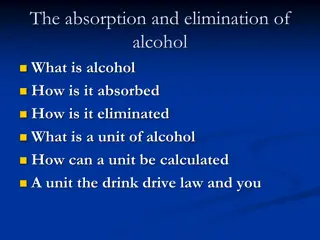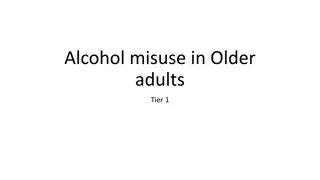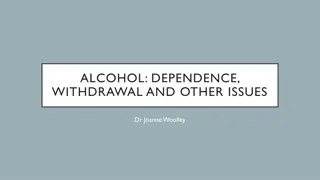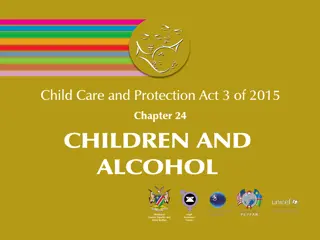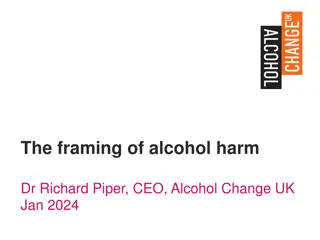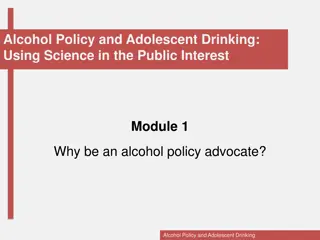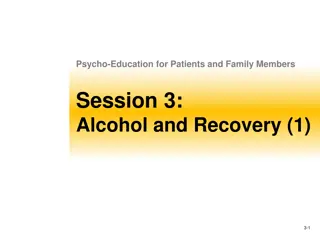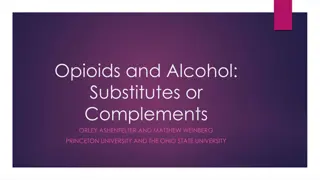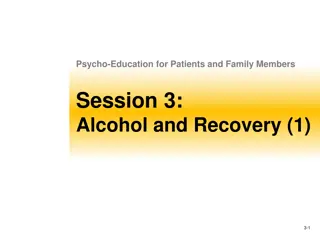Effects of Alcohol Consumption on Heart Health
Several studies suggest a U-shaped relationship between alcohol intake and mortality. Moderate drinking appears beneficial for heart health, while both abstinence and heavy drinking increase mortality risk. Recommendations advise women to limit alcohol to one drink per day and men to two drinks per day due to varying risks associated with alcohol consumption. Benefits of moderate alcohol consumption include increased HDL cholesterol, reduced risk of heart attack and dementia, and prevention of silent strokes. However, excessive alcohol consumption can lead to negative effects such as liver cirrhosis, cancer, and accidents.
Download Presentation

Please find below an Image/Link to download the presentation.
The content on the website is provided AS IS for your information and personal use only. It may not be sold, licensed, or shared on other websites without obtaining consent from the author. Download presentation by click this link. If you encounter any issues during the download, it is possible that the publisher has removed the file from their server.
E N D
Presentation Transcript
Alcohol and your heart Beth A. Kalicki Heli J. Roy, RD, PhD Pennington Biomedical Research Center
Key thoughts Several large studies show that alcohol consumption results in a U-shaped curve. Both abstainers and heavy drinkers have higher mortality than moderate drinkers. Heavy drinking can result in deleterious effects such as cirrhosis of the liver, increased rates of cancer and accidents. Those that consume no or little alcohol, are at a higher risk of mortality from cardiovascular disease 3/12/2010 PBRC 2010 2
Key thoughts Relative Risk of Mortality 2 Alcohol has both good and bad effects. It can have good effects at small intake levels. High intake can quickly lead to very harmful effects. 1.5 1 RR 0.5 0 0 >69d 1-6d 7-13d 14-27d 28-41d 42-69d Drinks/week 3/12/2010 PBRC 2010 3
1.8 Alcohol consumption and Alcohol consumption and relative risk of death from relative risk of death from heart disease and cancer heart disease and cancer With increased alcohol consumption, the relative risk of mortality increases for cancer (red) vs heart disease (blue). 1.6 Relative risk of mortality 1.4 1.2 1 RR-HD RR-C 0.8 0.6 0.4 0.2 0 Drinks/day 3/12/2010 PBRC 2010 4
Recommendations Due to the U-shaped curve, the recommendations for alcohol intake are: Women no more than 1 drink a day. Men no more than 2 drinks a day. This recognizes the fact that alcohol has some protective effect on cardiovascular disease, but the risk for other diseases increases quickly with increased consumption. 3/12/2010 PBRC 2010 5
Alcohol serving sizes 3/12/2010 PBRC 2010 6
Benefits of moderate alcohol consumption Increases HDL (good) cholesterol (~ 12%) Resveratrol prevents stickiness of platelets Decreases risk of a heart attack Reduces risk of diabetes Reduces risk of heart disease Lowers risk of dementia May prevent silent strokes 3/12/2010 PBRC 2010 7
Benefits of moderate alcohol consumption Inhibits the constriction of the coronary arteries limits clot formation decreases levels of homocysteine Lowers rate of obesity 3/12/2010 PBRC 2010 8
Benefits of moderate alcohol consumption There is a change in biological markers for coronary heart disease. Alcohol increased concentrations of high density lipoprotein cholesterol, apolipoproteinA I, and triglyceride. A survey of research shows that an intake of 30 g of alcohol a day (two drinks) would cause an estimated reductionof 24.7% in risk of coronary heartdisease. Alcohol intake lowers therisk of coronary heart disease through changes in blood lipids and blood flowfactors. BMJ 1999;319:1523-1528 PBRC 2010 3/12/2010 9
Benefits of moderate alcohol consumption Men reduced risk of heart attack and heart disease Women decreased risk of death from cardiovascular disease 3/12/2010 PBRC 2010 10
Pattern of alcohol consumption is important Small amount daily is associated with better health and increased longevity Consuming seven to fourteen drinks once a week is associated with negative health (binge drinking). 3/12/2010 PBRC 2010 11
Harmful effects of alcohol > 3 drinks = direct toxic effect on the heart High intake of alcohol results in high blood pressure high triglyceride levels congestive heart failure alcoholic cardiomyopathy (enlarged and diseased heart) increased incidence of heart disease and stroke 3/12/2010 PBRC 2010 12
Binge Drinking Binge drinking = more than 3 or 4 drinks in a short time. Increases risk of: atrial fibrillation cardiac arrhythmia (irregular heart beat) 3/12/2010 PBRC 2010 13
Excessive alcohol intake Can lead to: weakening of heart muscle hemorrhagic stroke cirrhosis of the liver pancreatitis certain cancers trauma suicide homicide 3/12/2010 PBRC 2010 14
Excessive alcohol intake Long term excessive alcohol use: irreversible brain damage impaired thinking unsteady walk slowed speech These results are irreversible even if a person discontinues alcohol consumption. 3/12/2010 PBRC 2010 15
When not to consume alcohol The American Heart Association recommends The American Heart Association recommends that you do not consume alcohol if you have: that you do not consume alcohol if you have: Personal or strong family history of alcoholism. Uncontrolled high blood pressure High blood triglyceride levels Pancreatitis Liver disease Porphyria Heart Failure Pregnancy Are using medications that can have adverse reactions with alcohol. 3/12/2010 PBRC 2010 16
Recommendations by the American Heart Association The American Heart Association recommends traditional methods for preventing heart disease. These include: Consuming a healthy diet Exercising Controlling blood cholesterol Remaining a healthy weight Controlling blood pressure within normal ranges 3/12/2010 PBRC 2010 17
Normal Heart vs. Normal Heart vs. Alcoholic Heart Alcoholic Heart The Enlarged Heart of an Alcoholic A Normal Size Human Heart 3/12/2010 PBRC 2010 18
Pennington Biomedical Research Pennington Biomedical Research Center Center Authors: Beth A. Kalicki Heli J. Roy, RD, PhD Division of Education Phillip Brantley, PhD, Director Pennington Biomedical Research Center Steven Heymsfield, MD, Executive Director 3/12/2010 PBRC 2010 19
About Pennington The Pennington Biomedical Research Center is a world-renowned nutrition research center. Mission: Mission: To promote healthier lives through research and education in nutrition and preventive medicine. The Pennington Center has several research areas, including: Clinical Obesity Research Experimental Obesity Functional Foods Health and Performance Enhancement Nutrition and Chronic Diseases Nutrition and the Brain Dementia, Alzheimer s and healthy aging Diet, exercise, weight loss and weight loss maintenance The research fostered in these areas can have a profound impact on healthy living and on the prevention of common chronic diseases, such as heart disease, cancer, diabetes, hypertension and osteoporosis. The Division of Education provides education and information to the scientific community and the public about research findings, training programs and research areas, and coordinates educational events for the public on various health issues. We invite people of all ages and backgrounds to participate in the exciting research studies being conducted at the Pennington Center in Baton Rouge, Louisiana. If you would like to take part, visit the clinical trials web page at www.pbrc.edu or call (225) 763-3000. 3/12/2010 PBRC 2010 20
References 1. American Heart Association. (2009). Alcohol, Wine, and Cardiovascular Disease. Alcohol Cardiovascular Disease. Retrieved August 12, 2009, fromhttp://www.americanheart.org/ print_presenter.jhtml?identifier=4422 Johns Hopkins Medicine. (2005). Alcohol and Heart Attacks: Does a Drink a Day Lower Your Risk? Health Alerts. Retrieved August 12, 2009, from http://www.johnshopkinshealthalerts.com/reports/ heart_health/265-1.html?type=pf Women s Heart Foundation. (2007). Alcohol and Heart Disease. Heart Disease. Retrieved August 12, 2009, from http://www.womensheart.com/content/HeartDisease/ alcohol_and_heart_disease.asp Breslow, R.A., and Smothers, B.A. Drinking pattern and body mass index in never smokers: National Health Survey, 1997-2001. American Journal of Epidemiology, 2005, 161(4), 368-376. Liu B, et al "Body mass index and risk of liver cirrhosis in middle aged UK women: prospective study" BMJ 2010; DOI: 10.1136 Wall TL, Carr CG, and Ehlers CL.Protective Association of Genetic Variation in Alcohol Dehydrogenase With Alcohol Dependence in Native American Mission Indians . Am J Psychiatry 160:41-46, January 2003. Forn-Fr as C, Sanchis-Segura C. The possible role of acetaldehyde in the brain damage caused by the chronic consumption of alcohol. Rev Neurol. 2003 Sep 1-15;37(5):485-93. National Institute on Alcohol Abuse and Alcoholism. NIH. Alcohol Alert. No 72, July 2007. 2. 3. 4. 5. 6. 7. 8. 3/12/2010 PBRC 2010 21


